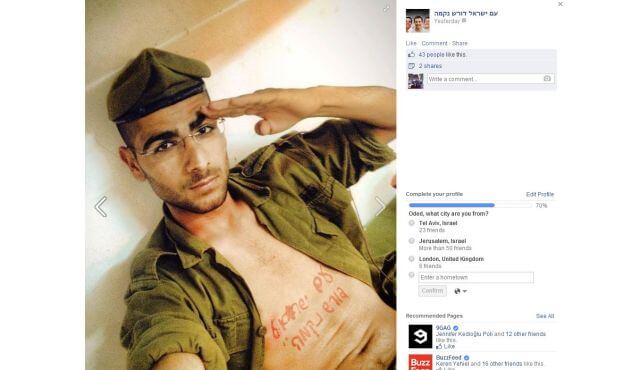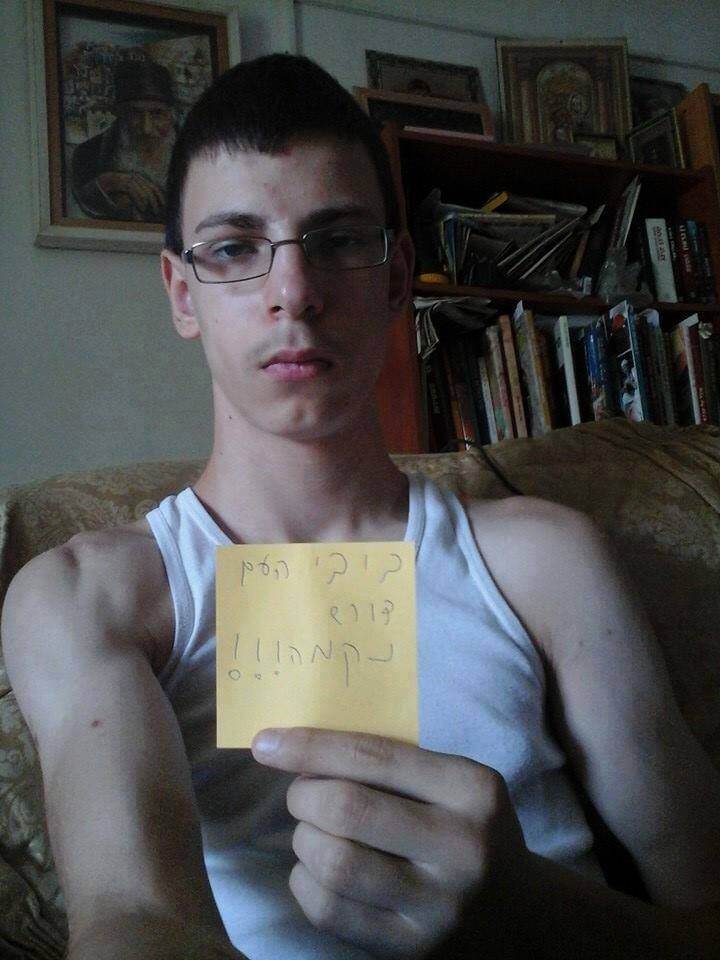The following is an excerpt from the new book Digital Militarism: Israel’s Occupation in the Social Media Age. Authors Adi Kuntsman and Rebecca L. Stein define digital militarism as “the ways that social media tools, technologies, and practices can be employed in the service of militant projects by both state and everyday civilian users. Of course, digital militarism is a broad and flexible concept, with wide global applicability. In this book, we consider the ways it has emerged in the context of Israel’s occupation.”
“Hating Arabs isn’t racism, it’s values!” #IsraelDemandsRevenge
Israeli selfie, July 2014 [1]
“#Revenge is the new feel-good summer hit in the Middle East.”
Haaretz, July 2014 [2]
In the summer of 2014, the devastating Israeli bombardment of the Gaza Strip unfolded in real time on our social media feeds. As Israeli bombs fell, as Palestinian civilian fatalities mounted, Palestinian journalists and residents from Gaza provided a constant stream of updates from the ground—video clips of the bombings, photographs of their destroyed homes, bloody images of children dying in hospitals, personal testimonies of terror and rage. Among global media pundits and anti-occupation activists bearing witness from afar, there was a sense that Palestinian wartime suffering and testimonials, easily accessible on our mobile screens, had never been more immediate. [3] Many Gazans invested considerable hope in this new digital reality—wondering if perhaps this time viral witnessing from Palestine might catalyze real political change. [4]
A very different social media field was unfolding concurrently in Israel, where digital militarism was being performed at unprecedented scales and degrees. During the course of the Gaza offensive, calls for violent attacks on Palestinians and Israeli leftists proliferated on Israeli social networks. The Israeli police and Justice Ministry reported growing “crimes of incitement” on social media, resulting in a dedicated “incitement hotline” to handle their volume. [5] Jewish Israeli users swapped detailed instructions on reporting “anti-Israeli” Facebook pages; Israeli journalists offered advice to parents (“Online Incitement: It’s Up to the Parents,” in the words of one headline); many mulled the question of whether “employees [should] get fired because of Facebook.” Their answers varied considerably depending on the identity of the user: while most Israeli Jews were merely disciplined for hate speech, condemnation of the military operation by Israel’s Palestinian citizens often ended in employment termination or institutional retribution at universities. [6]
Digital militarism had been growing in the weeks leading up to the Israeli offensive—particularly so following the abduction and killing of three Israeli settler teens by Palestinians from the West Bank, actions that catalyzed the Israeli bombardment (or, as some argued, had been used as its pretense). In response, as some Jewish Israeli extremist mobs roamed Israel’s streets hunting Palestinian victims, others turned to Facebook to call for vengeance: “The People of Israel Demand Revenge.” [7] The page quickly went viral, with thirty-four thousand “likes” in the day after its launch. Israeli fans voiced their support in the language of the selfie, uploading self-portraits with handmade placards demanding retribution (images below). Aside from the placards and the companion hashtag (#IsraelDemandsRevenge), most of these selfies made no reference to violence. Their content was ordinary: a man in his living room surrounded by children’s toys; smiling teenage girls, their heads touching in a gesture of friendship; a dog with puppies nested on an armchair. The signs were equally commonplace, written on Post-It notes or pages torn from school notebooks. As such, these selfies exemplified a central dynamic of digital militarism: its interplay of violence and ordinary intimacy.

Israeli selfie campaign calling for violent retribution against Palestinians. Handwritten text on body reads, “The people of Israel demand revenge” (in Hebrew). (Source: https://www.facebook.com/AmIsraelDoreshNekama)
The object of #revenge was not specified on Facebook, but everyone knew the implied target: “Death to the Arabs,” “Death to every terrorist”—slogans that would be repeated in political demonstrations, on radio talk shows, and in Internet comments in the heated days that followed. These slogans have a long history, popular among settler extremists during times of perceived political or military threat. But they proliferated in the wake of the 2014 kidnapping, as ideologies once relegated to Israel’s social peripheries were embraced by those in the mainstream, spreading virally through social networking. Some Israelis heeded the call in a very literal sense: the day the Facebook page went live, Israeli police discovered the burned body of a Palestinian teen, the victim of an Israeli revenge killing. [8] “This is a wake-up call,” said a few Israeli voices from the left. “A line has been crossed.” [9] But the violence would only grow, moving into state hands. In the week that followed, the Israeli military bombardment of the Gaza Strip would begin.

Post-it note reads, “Bibi, the people of Israel demand revenge” (in Hebrew). (Source: https://www.facebook.com/AmIsraelDoreshNekama)

Poster reads, “Hating Arabs isn’t racism, it’s values!” (in Hebrew). (Source: https://www.facebook.com/AmIsraelDoreshNekama)
In some sense, the digital militarism that unfolded during the course of the military incursion took rather predictable forms, albeit at greater scales and degrees: the patriotic mobilization, the military propaganda efforts, the racist tweets and posts, the beautified soldier selfies, the joyful celebration of Palestinian deaths, the discourse of digital suspicion. [10] All epitomized developments of the two decades prior, a period that had culminated in the gradual normalization of digital militarism. And yet, the digital militarism of this moment went one step further. Recall the viral selfie campaign in support of an aggressive Israeli soldier that had unfolded a few months prior (explored in Chapter 5). In this earlier instance, selfie solidarity had stood at something of a distance from soldier violence – supporting and abetting violence through the selfie, but at something of a distance from the scene of aggression. The #revenge campaign that gathered strength in the summer of 2014 had narrowed this distance. In this instance, Israelis were boldly and clearly called for vengeance from their own social media accounts, employing selfies to collectively demand violent retribution.
Israeli digital militarism has long promoted state violence against Palestinians. Yet extremist violence—namely, calls for the killing of Palestinians—had long been confined to the social media margins or staged in euphemistic terms. In the summer of 2014, the Israeli dream of killing moved out of the social media’s shadows. The #revenge selfies called for violence in unequivocal terms. Here, Israelis were demanding immediate retribution, summoning reprisal attacks against Palestinians. And tragically, with the Gaza offensive of that summer, the state would comply.
Notes
1. Schechter, “Selfies in the Service of Hate.”
2. Ibid.
3. One U.S. pundit wrote, during the course of the incursion, “Social media have helped allow us to see more deeply inside war zones—in this case, inside Gaza—and allowed viewers much fuller access to the terror that grips a population under military attack.” Wallace-Wells, “Why Israel Is Losing the American Media War.” This sentiment was shared by many, including reporter David Carr. Carr, “At Front Lines, Bearing Witness in Real Time.”
4. For discussion along these lines, see “Social Media: The Weapon of Choice in the Gaza-Israel Conflict.”
5.“Hotline, That’s What I Have?”
6. Bi’our and Weisburg, “‘Death to Arabs’”; Cook, “Israel’s Gaza Backlash Targets Arab Minority”; “Protective Edge: The War of Reports on Facebook”; Tsuk, “Online Incitement.”
7. Baharir, “Israelis Launch Facebook Campaign Calling for ‘Revenge’ of Teens’ Murders”; Schechter, “Selfies in the Service of Hate.”
8. Hasson, “Murder of Palestinian Teen Was No ‘Honor Killing,’ Says His Family.”
9. Kershner, “6 Israelis Held Over the Killing of Palestinian.”
10. In a variant of digital suspicion, Prime Minister Netanyahu infamously accused Hamas of using images of the Palestinian dead as a public relations tool. In his words, “They want to pile up as many civilian dead as they can. . . . They use telegenically dead Palestinians for their cause. They want the more dead, the better.” See Weiner, “Netanyahu: Hamas Wants ‘Telegenically Dead Palestinians.’”
Source Article from http://mondoweiss.net/2015/05/revenge-militarism-occupation
 RSS Feed
RSS Feed















 May 20th, 2015
May 20th, 2015  Awake Goy
Awake Goy 
 Posted in
Posted in  Tags:
Tags: 













